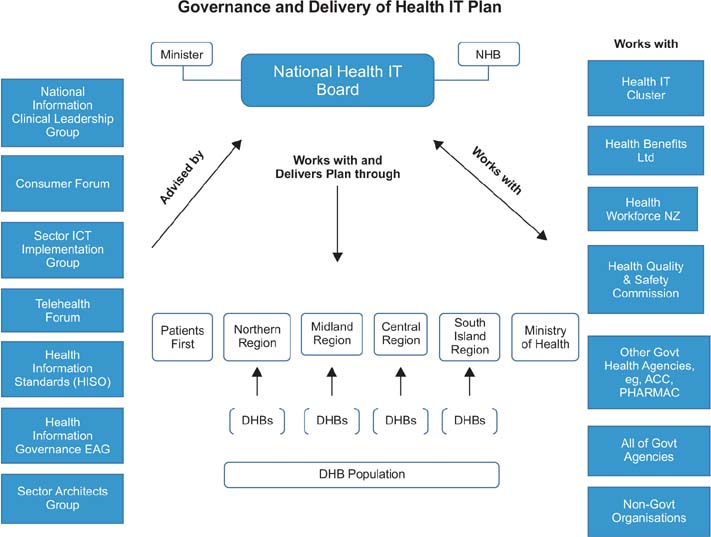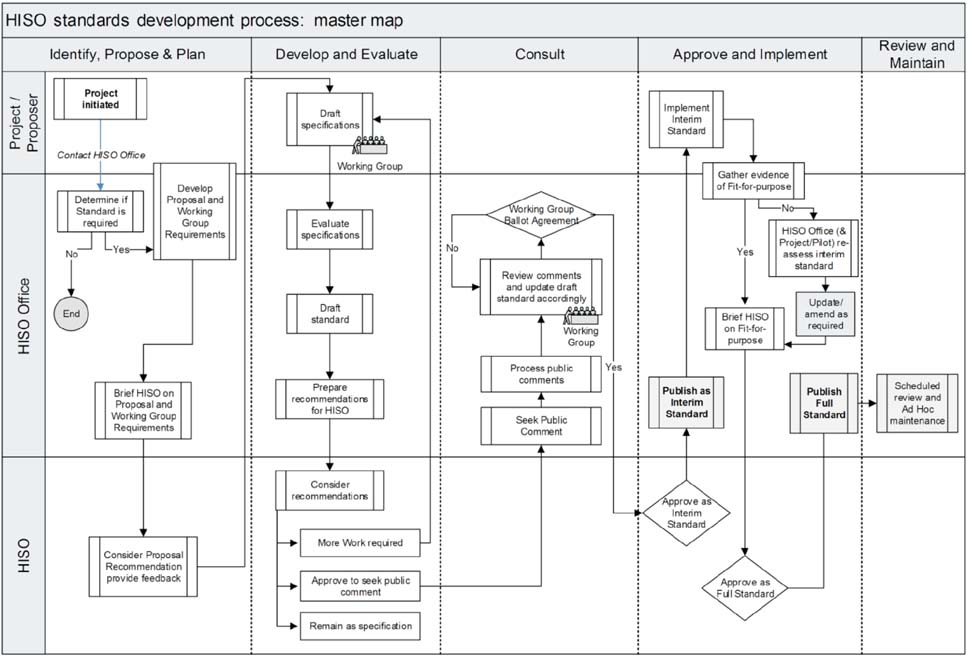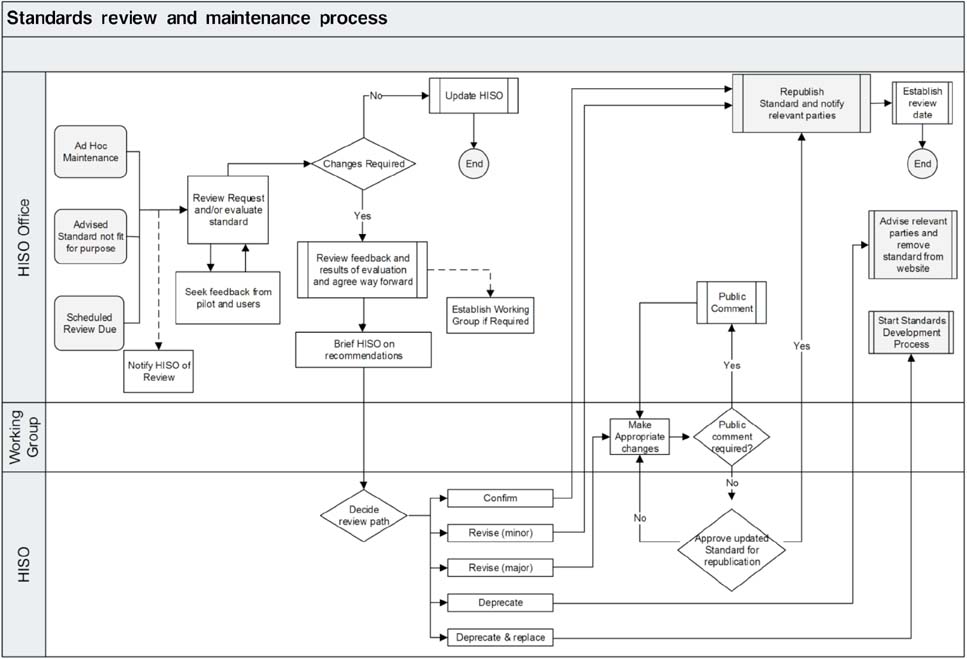Healthc Inform Res.
2015 Jul;21(3):144-151. 10.4258/hir.2015.21.3.144.
Current National Approach to Healthcare ICT Standardization: Focus on Progress in New Zealand
- Affiliations
-
- 1Research Institute for Health Insurance Review & Assessment, Health Insurance Review & Assessment Service, Seoul, Korea.
- 2Auckland Bioengineering Institute, University of Auckland, Auckland, New Zealand. k.atalag@auckland.ac.nz
- 3National Institute for Health Innovation, University of Auckland, Auckland, New Zealand.
- KMID: 2125182
- DOI: http://doi.org/10.4258/hir.2015.21.3.144
Abstract
OBJECTIVES
Many countries try to efficiently deliver high quality healthcare services at lower and manageable costs where healthcare information and communication technologies (ICT) standardisation may play an important role. New Zealand provides a good model of healthcare ICT standardisation. The purpose of this study was to review the current healthcare ICT standardisation and progress in New Zealand.
METHODS
This study reviewed the reports regarding the healthcare ICT standardisation in New Zealand. We also investigated relevant websites related with the healthcare ICT standards, most of which were run by the government. Then, we summarised the governance structure, standardisation processes, and their output regarding the current healthcare ICT standards status of New Zealand.
RESULTS
New Zealand government bodies have established a set of healthcare ICT standards and clear guidelines and procedures for healthcare ICT standardisation. Government has actively participated in various enactments of healthcare ICT standards from the inception of ideas to their eventual retirement. Great achievements in eHealth have already been realized, and various standards are currently utilised at all levels of healthcare regionally and nationally. Standard clinical terminologies, such as International Classification of Diseases (ICD) and Systematized Nomenclature of Medicine - Clinical Terms (SNOMED-CT) have been adopted and Health Level Seven (HL7) standards are actively used in health information exchanges.
CONCLUSIONS
The government to New Zealand has well organised ICT institutions, guidelines, and regulations, as well as various programs, such as e-Medications and integrated care services. Local district health boards directly running hospitals have effectively adopted various new ICT standards. They might already be benefiting from improved efficiency resulting from healthcare ICT standardisation.
Keyword
MeSH Terms
Figure
Reference
-
1. Kaelber DC, Bates DW. Health information exchange and patient safety. J Biomed Inform. 2007; 40:6 Suppl. S40–S45.
Article2. Shade SB, Chakravarty D, Koester KA, Steward WT, Myers JJ. Health information exchange interventions can enhance quality and continuity of HIV care. Int J Med Inform. 2012; 81(10):e1–e9.
Article3. Shapiro JS, Mostashari F, Hripcsak G, Soulakis N, Kuperman G. Using health information exchange to improve public health. Am J Public Health. 2011; 101(4):616–623.
Article4. Lee M, Heo E, Lim H, Lee JY, Weon S, Chae H, et al. Developing a common health information exchange platform to implement a nationwide health information network in South Korea. Healthc Inform Res. 2015; 21(1):21–29.
Article5. Fridsma D. Health IT standards in the United States and around the world [Internet]. Washington (DC): Health IT Buzz;2013. cited at 2015 Jul 1. Available from: www.healthit.gov/buzz-blog/electronic-healthand-medical-records/health-standards-united-statesaround-the-world/.6. World Health Organization. Framework and standards for country health information systems. Geneva, Switzerland: World Health Organization;2008.7. Health Information and Quality Authority. Overview of healthcare interoperability standards. Dublin, Ireland: Health Information and Quality Authority;2013.8. American National Standards Institute. Resources: Standards Developing Organizations (SDOs) [Internet]. Washington (DC): American National Standards Institute;c2015. cited at 2015 Jul 1. Available from: www.standardsportal.org/usa_en/resources/sdo.aspx.9. ASTM International [Internet]. West Conshohocken (PA): ASTM;c2015. cited at 2015 Jul 1. Available from: www.astm.org/.10. National Institute of Standards and Technology. CCR suitability analysis (NIST GCR 11-936). East Thetford (VT): Lantana Consulting Group;2011.11. American National Standards Institute [Internet]. Washington (DC): American National Standards Institute;c2015. cited at 2015 Jul 1. Available from: www.ansi.org/.12. Department of Health and Human Services. Health information technology: initial set of standards, implementation specifications, and certification criteria for electronic health record technology (final rule). Fed Regist. 2010; 75(144):44590–44654.13. The Office of the National Coordinator for Health Information Technology. 2015 Interoperability standards advisory: best available standards and implementation [Internet]. Washington (DC): The Office of the National Coordinator for Health Information Technology;2015. cited at 2015 Jul 1. Available from: http://www.healthit.gov/sites/default/files/Advisory_Fact_Sheet.pdf.14. British Standards Institution [Internet]. Bristol: British Standards Institute;2015. cited at 2015 Jul 1. Available from: www.standardsuk.com/bsi/.15. British Standards Institution. A standard for standards: principles of standardisation. Bristol: British Standards Institute;2011.16. Standards Australia [Internet]. Sydney: Standard Australia;c2015. cited at 2015 Jul 1. Available from: www.standards.org.au/OurOrganisation/AboutUs/Pages/default.aspx.17. Standards Australia. Annual review 2014 [Internet]. Sydney: Standard Australia;2014. cited at 2015 Jul 1. Available from: www.standards.org.au/OurOrganisation/AboutUs/Documents/W-0964%20AR-2014.pdf.18. The National E-Health Transition Authority [Internet]. Sydney: The National E-Health Transition Authority;2015. cited at 2015 Jul 1. Available from: www.nehta.gov.au/.19. Tolbert PS, Zucker LG. Institutional source of change in the formal structure of organizations: the diffusion of civil service reform, 1880-1935. Adm Sci Q. 1983; 28(1):22–39.
Article20. Hodgson GM. The return of institutional economics. In : Smelser NJ, Swedberg R, editors. The handbook of economic sociology. Princeton (NY): Princeton University Press;1994. p. 58–76.21. Scott WR. Institutional theory: contributing to a theoretical research program. In : Smith KG, Hitt MA, editors. Great minds in management: the process of theory development. Oxford: Oxford University Press;2005. p. 460–485.22. National Health IT Board. Health Information Standards Organization (HISO) [Internet]. Wellington, New Zealand: Ministry of Health;2015. cited at 2015 Jul 1. Available from: ithealthboard.health.nz/healthit-groups/health-information-standards-organisationhiso.23. New Zealand Ministry of Health. Operational Policy Framework 2014/15 [Internet]. Wellington: Ministry of Health;c2015. cited at 2015 Jul 1. Available from: nsfl.health.govt.nz/accountability/operational-policy-framework/operational-policy-framework-201415.24. Health Information Standard Organization. Standards processes [Internet]. Wellington, New Zealand: Health Information Standards Organization;2013. cited at 2015 Jul 1. Available from: healthitboard.health. govt.nz/system/files/documents/publications/standardsprocesses-apr-13.pdf.25. National Health Board. Our structure [Internet]. Wellington, New Zealand: National Health Board;2014. cited at 2015 Jul 1. Available from: nhb.health.govt.nz/about-us/our-structure.26. Health Information Standard Organization. Health Information Standard Organization terms of reference [Internet]. Wellington, New Zealand: Health Information Standards Organization;2013. cited at 2015 Jul 1. Available from: healthitboard.health.govt.nz/system/files/documents/pages/hiso-terms-referenceaug-2013.pdf.27. New Zealand Ministry of Health. National Health IT Plan Update 2013/14 [Internet]. Wellington: Ministry of Health;2013. cited at 2015 Jul 1. Available from: www.health.govt.nz/publication/national-health-itplan-update-2013-14.28. Hay D, Maitre AL, Kenworthy A, Atalag K. Interoperability Reference Architecture [Internet]. Wellington, New Zealand: Health Information Standards Organization;2011. cited at 2015 Jul 1. Available from: ithealthboard.health.nz/system/files/documents/publications/interoperability-reference-architecture-v-1.pdf.29. Health Information Standards Organisation. HISO 10040 health information exchange architecture [Internet]. Wellington, New Zealand: Health Information Standards Organization;2012. cited at 2015 Jul 1. Available from: www.ithealthboard.health.nz/content/health-information-exchange-architecturebuilding-blocks.30. openEHR specifications [Internet]. [place unknown]: openEHR Foundation;c2015. cited at 2015 Jul 1. Available from: www.openehr.org.31. Benson T. Principles of health interoperability HL7 and SNOMED. 2nd ed. London: Springer-Verlag;2012.
- Full Text Links
- Actions
-
Cited
- CITED
-
- Close
- Share
- Similar articles
-
- Current Status of Electronic Medical Record Systems in Hospitals and Clinics in Korea
- Use of Robots as a Creative Approach in Healthcare ICT
- Recent trends of healthcare information and communication technologies in pediatrics: a systematic review
- Acceptability of Service Targets for ICT-Based Healthcare
- Integration of information and communication technology in emergency medical services: The Chungbuk Smart Emergency Service Project





